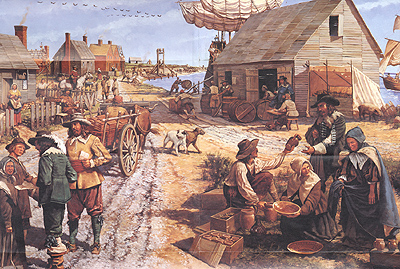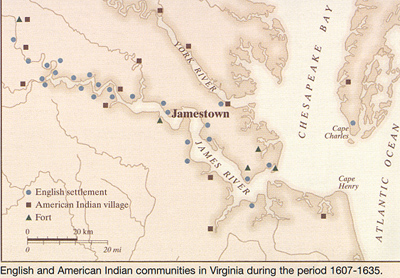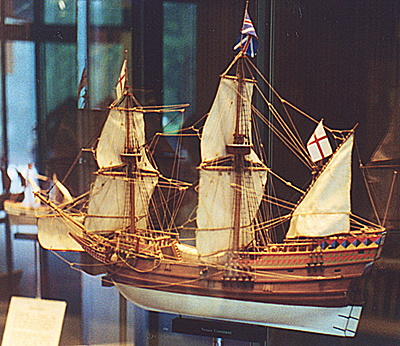 On May 13, 1607, 104 Englishment arrived on an island they called Jamestown. After four and a half months at sea in three ships, the smallest called the Discovery and being about the size of a school bus, the largest called the Susan Constant just over twice that size, and the Godspeed in the middle, the land must have looked good in the spring. Yet for most of these colonists, it would be their grave.
On May 13, 1607, 104 Englishment arrived on an island they called Jamestown. After four and a half months at sea in three ships, the smallest called the Discovery and being about the size of a school bus, the largest called the Susan Constant just over twice that size, and the Godspeed in the middle, the land must have looked good in the spring. Yet for most of these colonists, it would be their grave.
Illustration from the NPS pamplet showing Jamestown circa 1660s. At left, newly arrived servants talk to their master. At rear center, hogsheads of tobacco (barrels) are rolled to a waiting English ship. At rear left, planters look over newly arrived slaves. In the foreground right, a merchant shows his pottery wares.
Under a charter from King James I, the colonists established the colony of Virginia, with Jamestown as its capital. Captain John Smith lead the building of a three-sided wooden fort and the clearing around the small village that soon took shape. However, by summer, disease ran rampant and the ground proved to be poor farmland. Starvation set in.
 One of the reasons the colonists decided to plant the colony on this island was that there were no natives. In the initial exploration around the Chesapeake Bay, the English found many tribes, which we know as the Powhatan, already established. With no wish to initiate hostilities so soon, they found a barren island in more ways than one. There were no natives on the island precisely because it was poor ground compared to the surrounding area. Its main use was seasonal hunting.
One of the reasons the colonists decided to plant the colony on this island was that there were no natives. In the initial exploration around the Chesapeake Bay, the English found many tribes, which we know as the Powhatan, already established. With no wish to initiate hostilities so soon, they found a barren island in more ways than one. There were no natives on the island precisely because it was poor ground compared to the surrounding area. Its main use was seasonal hunting.
Map from NPS.
Nonetheless, the natives traded food for beads and knives, and though the colony teetered, it survived the first winter. Still, a bad drought rolled in, and even the natives started to have food shortages. Although more Englishmen arrived, many died off. The winter of 1609-1610 was known as the "starving time," and virtually all of the colonists died. Indeed, only the arrival of hundreds more colonists in 1610 kept the town alive.
Somewhere in there emerged Pocahontas, the daughter of the chief of the Powhatan confederation of tribes. Legend has it she saved the life of John Smith, which may or may not have been as dramatic as depicted in legend, but she certainly married an English settler John Rolfe in 1614 and may have helped "discover" the cash crop which would ultimately save the colony: tobacco.
 Rolfe first attempted to grow tobacco in 1611. At the time, English tobacco was a bitter mess. The shipping of the first Virginia batch, evidently a far sweeter variety, caused a sensation in London. By 1618, 50,000 pounds of Virginia tobacco were shipped to England. The land grab was on. Most new colonists either bought land or got 50 free acres for buying a passage (a "headright"). If not, you could be an indentured servant for a number of years, then go on to start your own farm. As you can imagine, the colonists started spreading westward from Jamestown.
Rolfe first attempted to grow tobacco in 1611. At the time, English tobacco was a bitter mess. The shipping of the first Virginia batch, evidently a far sweeter variety, caused a sensation in London. By 1618, 50,000 pounds of Virginia tobacco were shipped to England. The land grab was on. Most new colonists either bought land or got 50 free acres for buying a passage (a "headright"). If not, you could be an indentured servant for a number of years, then go on to start your own farm. As you can imagine, the colonists started spreading westward from Jamestown.
A model of the Susan Constant, the flagship of the three-ship force that brought the first colonists in 1607. Commanded by Capt. Newport, the ship was 80 feet long, had a cargo capacity of 125 tons, and carried 71 colonists.
On July 30, 1619, the first elected burgesses met in the church, creating the first democratic assembly in the New World, or at least the first democratic representative government of white men in the New World. Ironically enough, the demand for tobacco labor outstripped available men, and so in 1619, the first African slaves appeared in Virginia. In 1620, 90 unmarried women arrived to further civilize the area. Pocahontas Rolfe, by the way, ended up in England, where she soon died of disease.
Pocahontas' father, who had at least been sympathetic to the settlers, died around 1620-21. Although skirmishes and raids occurred, and complaints about cheating during trades abounded, Virginia was a relatively peaceful place. The new native Indian leader, however, correctly surmised that something had to be done about all these encroaching foreigners--about 1000 now lived in scattered farms up and down the James River area.
In 1622, a full-scale war broke out between the Powhatans and Englishmen. Initial success and slaughter accounted for 347 dead Englishmen and women, but eventually, the English gained the upper hand and drove the Powhatans back. Evidently, with tobacco in such hot demand and Virginia the supply source, King James revoked the charter in 1624 and made it a royal colony.
By the time of the English Civil War, the colony remained loyal to King Charles I. As he lost the war and was shortly beheaded, the colony submitted to Parliament as soon as warships approached Jamestown in 1652. The monarchy under Charles II was subsequently restored, and a variety of Navigation Acts precluded trade with the Dutch, undermining Virginia's economy and angering the Dutch to boot. The Anglo-Dutch Wars brought a pair of forts to Jamestown, but the Dutch attacked the tobacco fleet.
 As the 1600s wound down, the flow of indentured servants dried up completely, while there was a corresponding increase in slaves. By 1690, 53,000 colonists owned 9300 slaves.
As the 1600s wound down, the flow of indentured servants dried up completely, while there was a corresponding increase in slaves. By 1690, 53,000 colonists owned 9300 slaves.
Map from NPS.
As a prelude to the American Revolution, backwoods settlers complained to the King about weak responses to native attacks. Nathanial Bacon gathered up a mob and created his own army to battle natives. Governor Berkeley raised troops to combat Bacon's independent streak, but while the governor was off, Bacon burned down Jamestown. Bacon was eventually killed, but the town did not recover. In 1698, the statehouse burned down, and in 1699, the capital was moved to Williamsburg, a more centrally located town to the increasingly populous Virginia colony.
In 1893, the Association for the Preservation of Virginia Antiquities purchased 22.5 acres of the site. In 1934, the rest of the 1500-acre island was bought by the National Park Service.
More Colonial Williamsburg
- Introduction and Colony History
Visitor's Center
Old Town
New Town
Five Mile Loop
Jumbo Illustration of 1600s Jamestown (monstrously slow: 1.3Mb)
Back to List of Historic Sites
Back to Travel Master List
Back to MagWeb Master List of Magazines
© Copyright 2003 by Coalition Web, Inc.
This article appears in MagWeb (Magazine Web) on the Internet World Wide Web.
Other articles covering military history and related topics are available at http://www.magweb.com